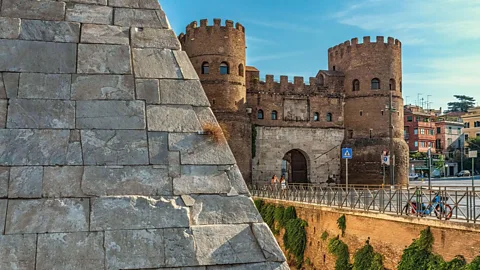 Alamy
AlamyOnce an important port that supplied food to ancient Rome, off-the-beaten-path Testaccio remains the city’s favourite culinary destination.
On a warm Saturday evening last autumn in Rome, I took two friends and first-time visitors, Boba and Smiljana, to Testaccio, a centrally located neighbourhood on the left bank of the Tiber River. We went to a party held twice a month at the Mercato di Testaccio (Testaccio Market), when stalls stay open late, offering classic Roman dishes like cacio e pepe, carbonara and supplì (deep-fried risotto balls) – alongside wine, beer and music.
Though visiting the market isn’t part of a typical traveller’s itinerary, Boba and Smiljana loved the detour. “Who needs a tourist-trap meal near the Colosseum when you can eat this?” Boba said, happily sinking her teeth into porchetta (stuffed, slow-roasted pork) sandwiches – a classic Roman street food.
From Grand Tour sightseers to religious pilgrims, Rome has always drawn visitors. But as 35 million tourists now descend on the Italian capital every year, the city has recently considered limiting access to some of its most famous sites in an effort to curb its growing overtourism problem.
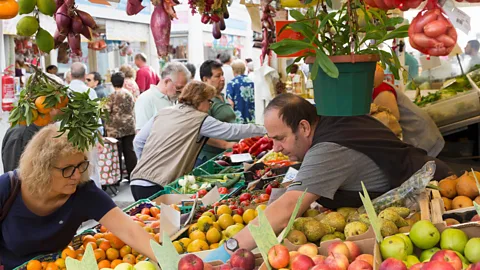 Alamy
AlamyWhile parts of Rome can feel like a historical theme park, Testaccio offers a refreshing glimpse into modern Roman life. You won’t find tourist mobs or gladiator-clad reenactors here. Instead, Romans from across the city flock here to shop for ingredients, chat with vendors – often in Roman dialect – and bite into what has always been one of the city’s favourite food destinations.
I’ve since returned to the Testaccio Market many times – not only for pizza bianca (bubbly, plain pizza dough sprinkled with salt) and vegan snacks, but also for the rich cultural heritage that pulses through – and even below – the market.
Rome is built on layers of history, stacked one on top of the other like a lasagna of eras. The Testaccio Market bears witness to this. The ground floor houses a modern market, the first floor has exhibits showcasing Testaccio’s 2,000-year-old role as the kitchen of ancient Rome, and below it all lies one of Rome’s most unique archaeological treasures: an amphora graveyard from the 1st to 3rd Centuries CE where vessels containing ancient ingredients are still buried.
“The Tiber River was the real entrance to the city of Rome in the ancient time,” said archaeologist Luca Mocchegiani Carpano, who leads free tours of the site below the market hall during its evening food parties.
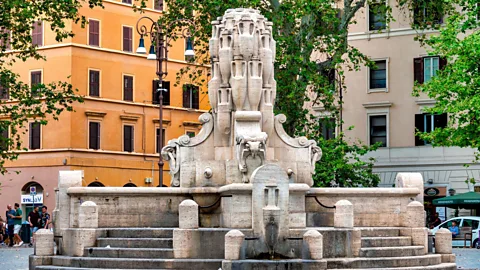 Alamy
AlamyMocchegiani Carpano explained that where Testaccio stands today, ancient Romans built the Emporium, a port that brought in goods from all over the Mediterranean. Established around 193 BCE, the Emporium was Rome’s largest inland port and was where goods such as olive oil, wine and fish arrived and were sold, subsidised or given for free to everyday Romans. During the 1st Century CE, under emperors like Claudius and Trajan, the area grew into a thriving commercial hub to feed the city’s growing population.
In ancient Rome, sauces, oils and many food items were transported in amphorae – a type of terracotta jar. These jars were stacked on ships and sealed to preserve their contents during long trips. Once emptied, amphorae were recycled into the walls of the port complex beneath today’s Testaccio Market or shattered and discarded. These shattered, discarded vessels eventually formed a 35m-tall hill of broken pottery, known as Monte Testaccio or “Monte dei Cocci” (literally: “Mountain of Shards”), which stands at the heart of today’s Testaccio neighborhood. In fact, the name “Testaccio” comes from the Latin word testae, which means “potsherd”.
After the fall of ancient Rome in 476 CE, the Testaccio area was largely abandoned and used as farmland. At the base of Monte Testaccio, Romans carved caves into the hill’s structure. Known as grottini (small cellars), these spaces were used to store wine and other goods. The porous fragments of amphorae that make up the hill helped maintain naturally cool and stable temperatures, ideal for preserving the stored items, and Testaccio became Rome’s de facto cupboard. Today, these caves house numerous restaurants – some of which feature ancient amphorae embedded in their walls, making dining an immersive historical experience.
Testaccio’s unique culinary heritage is perhaps best captured at the well-known restaurant Checchino dal 1887, which was originally established to serve the neighbourhood’s growing working-class community. During the late 19th Century, the industrial development of Rome and the opening of a nearby slaughterhouse, known as the Mattatoio, drew an influx of workers to Testaccio. Using leftover ingredients provided by the slaughterhouse workers, Romans began transforming humble ingredients like offal (so-called “fifth quarter“) into the flavourful dishes of the cucina povera – Rome’s “cuisine of the poor”.
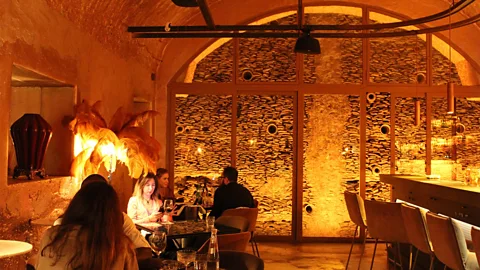 Lidija Pisker
Lidija PiskerOne such dish is coda alla vaccinara (oxtail stew), which is Checchino’s signature. Since the recipe was created using leftover meat from the slaughterhouse, it still relies on what is largely considered scraps. Poor in price but rich in taste, oxtail stew has since become one of Rome’s most iconic dishes and is now offered on menus across the city.
Over time, Checchino has grown from a humble eatery to a fine-dining establishment, achieving prestigious awards, including a Michelin star in 1991 and a spot on The World’s 50 Best Restaurants list in 2003. Despite its success, this family restaurant has preserved its simple, rustic setting at the foot of Monte Testaccio. It also offers a dedicated “historical menu” of the Roman cucina povera dishes that originated in the neighbourhood, such as insalata di zampi (a salad made with boned veal trotters), bucatini alla gricia (a pasta dish made with cured pork jowl) and cicoria di campo saltata (sauteed chicory with garlic and chilli pepper).
Da Oio, Felice, Perilli a Testaccio and Pecorino are other family-run restaurants in Testaccio that have preserved the authentic recipes of popular cucina povera dishes that have since become synonymous with modern Roman cuisine. Adventurous eaters shouldn’t leave Testaccio without trying coratella (lamb offal cooked with vegetables like artichokes), trippa alla romana (beef tripe with Pecorino cheese and mint) or rigatoni con la pajata (pasta with a sauce made from the intestines of milk-fed calves).
Today, the former slaughterhouse is a cultural centre focused on sustainability named Città dell’Altra Economia (CAE) (The City of Alternative Economy). Beyond its concerts, film screenings and other cultural programmes, CAE hosts a variety of food festivals. One of them, the Magna Roma Festival celebrates the city’s rich culinary heritage while cleverly playing on two meanings: in Latin, magna means “great”, while in Roman dialect, magna means “eat”.
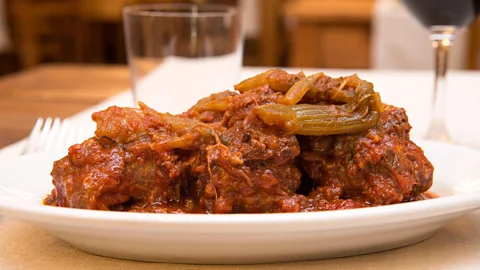 Alamy
AlamyThe CAE is also home to the Collettivo Gastronomico Testaccio, a restaurant founded by local chefs who use local ingredients to create traditional Roman dishes like pici e baccalà (thick, hand-rolled pasta, paired with baccalà, salted cod) and amatriciana (pasta with pork cheek, tomato sauce and Pecorino Romano cheese) with modern twists.
Despite its status as one of Rome’s last “Roman” neighbourhoods, Testaccio hasn’t been immune to the gentrification and touristification other parts of the city have experienced. In the last few decades, the area has gradually shifted from a working-class area to a more upscale district for artists, actors and young professionals. More recently, it is becoming increasingly popular with tourists, as numerous Airbnbs, more English-menu restaurants and food tours showcasing Testaccio’s Roman eateries and its market appear.
In May this year, when McDonald’s opened a restaurant in the building of Testaccio Market, local media called it an “affront to the heart of romanità“, the authentic spirit of Rome.
Marina Minucci, a translator, has called Testaccio home for the past two decades. “The changes began before I moved to Testaccio. But luckily enough, there’s still a good balance between new inhabitants and old residents, so-called Testaccini,” she said.
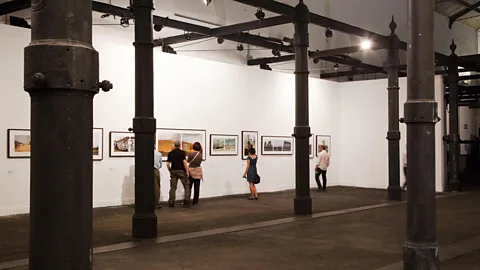 Getty Images
Getty ImagesFor Minucci, the real charm of living in Testaccio is its people, which has drawn her into the Gruppo di Acquisto Solidale Testaccio Meticcio (GAS), a group that purchases organic and sustainably produced food directly from local farmers. On Thursday evenings, Minucci and her fellow GAS members meet just an amphora’s throw away from Monte Testaccio to pick up their fresh vegetables, fruits, dairy and meats that the farmers drive into the city.
In a way, the group’s gatherings reflect the area’s historic role in food distribution, transformed into a sustainable, community-driven initiative. Their shared love for food has also fostered lasting friendships and big, communal dinners at local restaurants. Minucci says their next gathering is just around the corner: a Christmas dinner, where they will enjoy traditional Roman dishes that originated in Testaccio and raise a glass to the upcoming year.





